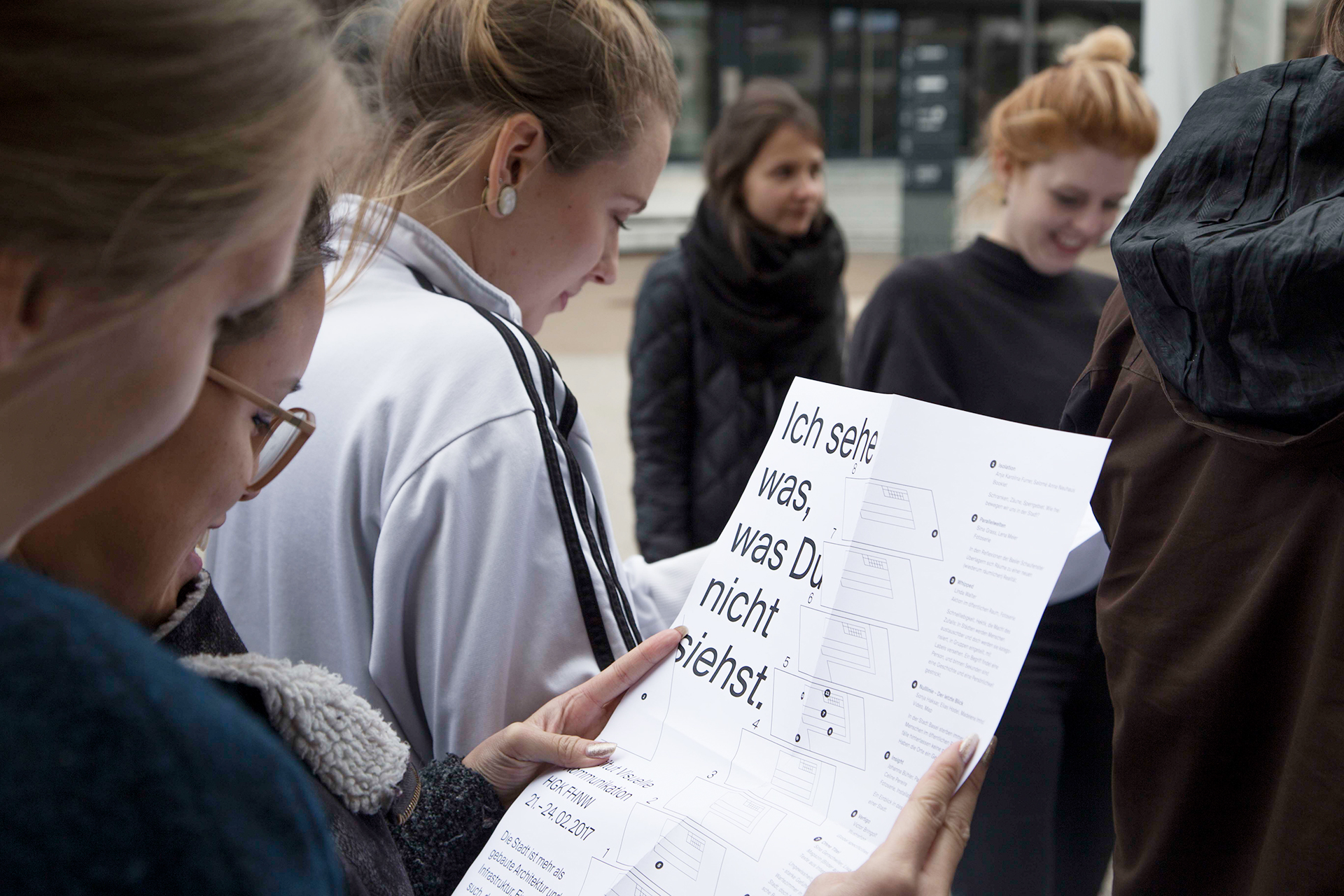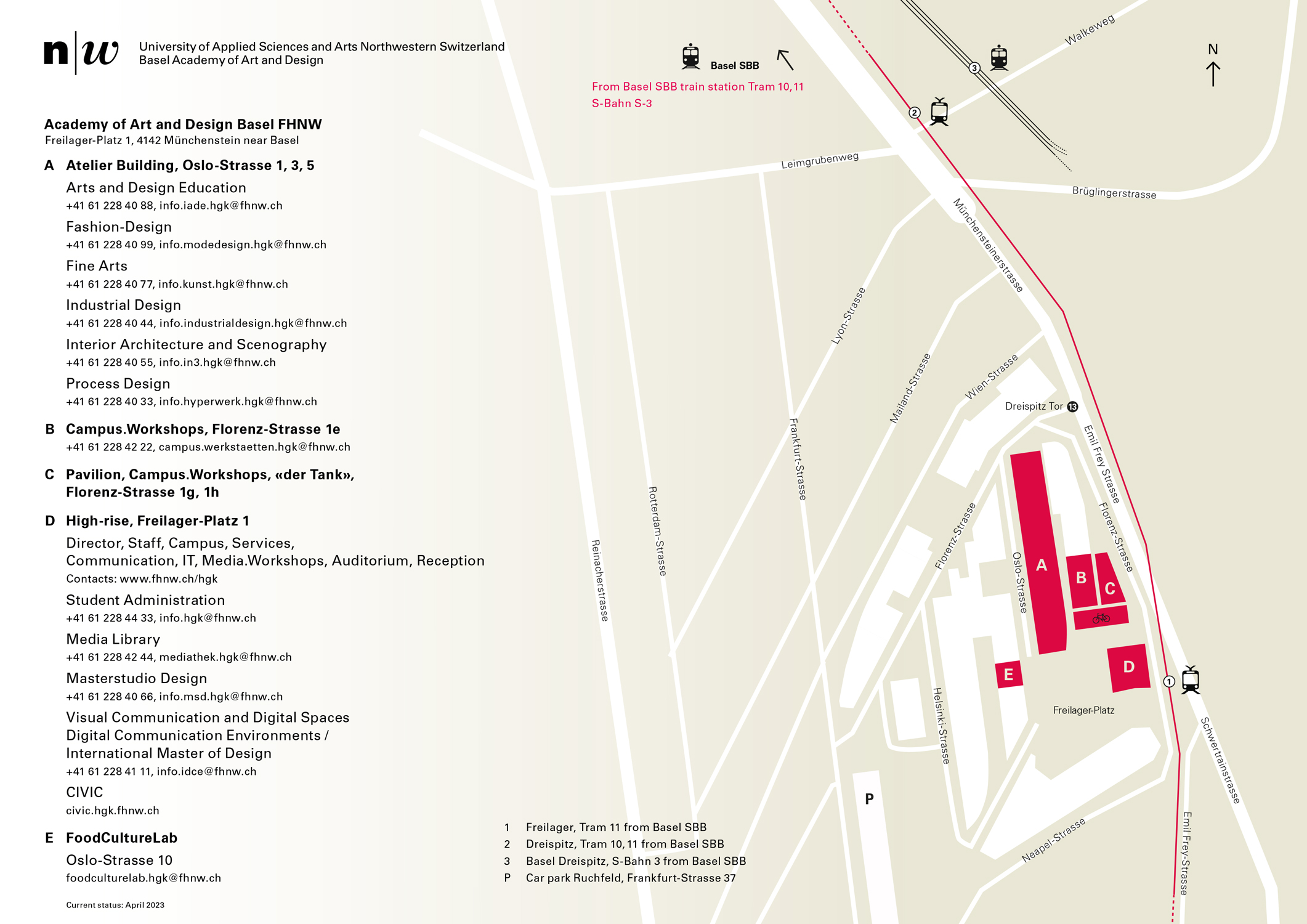Visual Communication and Digital Spaces BA
With the ongoing digital transformation and the increasing integration of Artificial Intelligence (AI), the importance of visual communication continues to grow. Developing a critical approach to images is becoming essential. In the Bachelor’s degree programme Visual Communication and Digital Spaces, the reflective development of text- and image-based messages for both everyday and specialised communication contexts is at the heart of the curriculum.
Key data
- Degree
- Bachelor of Arts FHNW
- ECTS points
- 180
- Study start
- Mon. 31.08.2026 (week 36)
- Next start
- Mon. 14.09.2026 | Fall Semester
- Final application date
- Sun, 15.02.2026
- Studying mode
- Fulltime
- Duration
- 6 Semester
- Teaching language
- German and English (B2 or equivalent)
- Place
- Basel
- Stay abroad
- Exchange semester abroad is possible
- Application fee
- CHF 200.- (incl. aptitude assessment and enrolment)
- Semester fee
- CHF 750 (CH); CHF 1.000 (EU); CHF 1.250 (Not-EU/EFTA) Fees detail
Application for the Bachelor's programme in Visual Communication and Digital Spaces.
Mobile navi goes here!



Information on programme contents
The aim of the programme Visual Communication and Digital Spaces is to equip students with the ability to conceptualise, explore, and apply visually powerful and conceptually compelling messages. Departing from conventional imagery plays a central role in the practice of visual communication. To meet this demand, students acquire technical, artistic, and analytical skills alongside traditional craft methods. Individual studio workspaces and well-equipped workshops provide them with the resources to pursue their projects in depth.
Study structure
When applying for the programme, students may choose between two specialisations: “Visual Communication” and “Digital Spaces”. These distinct emphases enable them to follow their individual design interests and to deepen their expertise in a chosen field. After completing an intensive two-semester foundation phase, they gradually develop their own design stance in the main study phase through individual project work.
Specialization Visual Communication
This specialisation is designed for students who wish to focus their design interests on approaches derived from analogue cultural techniques. Here they can further develop their creative potential by applying established design principles and methods. The emphasis lies on conceiving, designing, and analysing communication tools for both print- and screen-based media. Students work with classical approaches such as drawing, graphic formulation, photography, typographic composition and type design, as well as their digital equivalents in a wide range of creative software tools. Key areas of study include narration, corporate identity, book design, editorial design, information design, critical design, moving image, animation, and interface design. Alongside these, students reflect critically on established visual languages while at the same time experimenting with new and exploratory forms of visual expression.
Specialization Digital Spaces
This specialisation focuses on the design of digital communication environments. Technological developments serve as sources of inspiration for exploring new creative possibilities, extending well beyond standard software tools. Innovations in human–computer interaction, digital animation, generative design, creative coding, augmented and virtual reality, among others, provide starting points for the conception and design of messages within digital communication environments. Areas of study include UX/UI, motion design, data visualisation, digital identity, critical media, spatial staging, generative tool making, physical computing, and game design. With this broad and in-depth knowledge, students are well equipped to engage with technological innovations and to apply them in exemplary ways within communication contexts.
The Visual Communication and Digital Spaces bachelor’s programme is intended for students who demonstrate a strong talent in design. They can choose one of the two areas of specialisation depending on their preference.
Goals and benefits
Through the mix of theoretical knowledge and practical applications, bachelor’s students are able to design sophisticated visual messages and use them effectively in different analogue and digital communication fields. With a broad spectrum of teaching content and practice-oriented training, the study programme prepares students for a variety of professional opportunities. In addition, graduates are in a position to anticipate social changes and help solve these challenges with their creativity and skills. In this way they take active part in the social discourse on topics such as diversity or sustainability.
Career prospects
The Visual Communication and Digital Spaces bachelor’s programme prepares students specifically for the challenges of the steadily growing professional fields in which networked and analytical thinking, independent design, visual competence and technical and skilled know-how are needed. The goal of the study programme is to help you develop and advocate your own concise design position. Once you have graduated, you will be qualified to work as a designer of communicative messages. You can work in communication, media or corporate design agencies, publishing houses, the communication departments of companies and public institutions, in design offices or even in their own studio. This wide range of job opportunities enables you to use your creative skills in many ways and to move confidently in the professional world.
With its studios and central Campus.Workshops, HGK offers ideal conditions for combining craft curiosity, the acquisition of technical skills, and the necessary digital know-how. In addition, all students have their own 24/7 workspace in one of the spacious studios.
Information on admission, aptitude assessment and admission to the study programme
Educational requirements
For admission to the aptitude assessment for the bachelor’s programmes in Design (Industrial Design, Interior Architecture and Scenography, Fashion Design, Process Design, Visual Communication and Digital Spaces), one of the following qualifications is generally required:
- a certified vocational baccalaureate
- a certified specialized baccalaureate
- a certified upper secondary school (level II) baccalaureate
- proof of an equivalent educational degree at an upper secondary school (level II) obtained otherwise (Swiss education system)
Language of tuition
The language of tuition is German and partly English (both B2 or equivalent). Proof of language proficiency is required at the start of the degree programme.
Workplace experience or preparatory course in Design
In addition, candidates need to provide proof of one year of workplace experience or completion of a two-semester preparatory course in Design.
Is a list of approved vocational trainings and professional fields, respectively.
Catching up on the vocational baccalaureate
Applicants who have not completed at least three years of upper secondary schooling (level II) are not legally entitled to admission to a Bachelor's degree programme. Information concerning full-time or part-time on-the-job training courses focusing on a vocational, design-based or specialized baccalaureate is provided by the local vocational colleges.
Admission on the basis of exceptional talent (1)
In exceptional cases, applicants can be admitted to the Bachelor’s degree programmes without being in possession of an upper secondary school (level II) certificate (Swiss education system), namely if they can provide proof of exceptional talent, either in a design-related or an arts-related field.
Note: We recommend that you make enquiries by means of an email to the office of the respective degree programme at admission.BA-viskom.hgk@fhnw.ch at least two weeks prior to the application deadline (15 February), or arrange an appointment with the Head of the degree programme.
____________
(1) If you are in possession of one of the following educational degrees, you are eligible for this mode of admission:
Federal Certificate of Vocational Proficiency EFZ (apprenticeship), Professional Certificate EBA, Specialized Secondary School (FMS), Compulsory Schooling, no educational qualification
To apply for a place at the HGK Basel, the required documents must be submitted by deadline 15.02.2026.
Please send the specific enquiries to email address.
Dates aptitude assessment 2026
- 01.11.2025
Publication of the detailed information on the aptitude assessment - 15.02.2026
Registration deadline and deadline for submitting the required documents for the aptitude assessment. - 31.08. - 11.09.2026
Introductory weeks at the HGK Basel (mandatory) - 14.09.2026
Fall Semester begin 2026/27
Here you will find answers to FAQs about preparing and registering for a Bachelor’s (BA) or a Master’s (MA) degree programme at the HGK Basel FHNW.
Here you will find answers to organizational, administrative and legal questions all about studying -->
Insights Visual Communication and Digital Spaces BA
International students can find further information on the website of the International Office of the HGK Basel.

Public transport
The campus is easy to reach by public transport. The stop Freilager on BLT line 11 is immediately in front of the Campus (from Bahnhof SBB in direction Aesch)
By car
Leave the motorway A2 at the junction Basel-St. Jakob and follow the sign Dreispitz. Approaching from Münchensteinerstrasse enter the Dreispitz complex through Gate 13 and park your car in one of the public car parks (Ruchfeld or Leimgrube). When setting your satnav, please note that the Freilager complex is part of the municipality of Münchenstein, Canton Basel-Landschaft.
Access by car for people with disabilities
Choose the access via Florenz-Strasse in the direction of the High-rise building (Building D). To lower the bollard at the gates of the campus please ring the bell. You will be connected to our reception in Building D.

The buildings of the HGK Basel are accessible by wheelchair, stroller, and for people with walking difficulties. The entrance to the highrise building (Building D) is at ground level, the studio building (Building A) can be reached via a ramp. There is at least one lift in both buildings.
Access by car for people with disabilities: See Gender-neutral toilets: See ‘Getting there‘.
Toilets for people with disabilities:
Highrise building (Building D): Ground floor to 8th floor in the centre of the building
Studio building (Building A): Ground floor to 3rd floor, southern section of main corridor
Gender-neutral toilets: See ‘All Welcome WC’.
Parent-child-room: See 'Parent-child-room'.
Basel Academy of Art and Design FHNW
Institute Digital Communication Environments (IDCE)
Postfach
(P.O. Box)
CH-4002 Basel
Basel Academy of Art and Design FHNW
Institute Digital Communication Environments (IDCE)
Freilager-Platz 1, Hochhaus: D 5.03
4141 Münchenstein b. Basel
T +41 61 228 41 11
F +41 61 228 42 89
M info.vis_com.hgk@fhnw.ch

